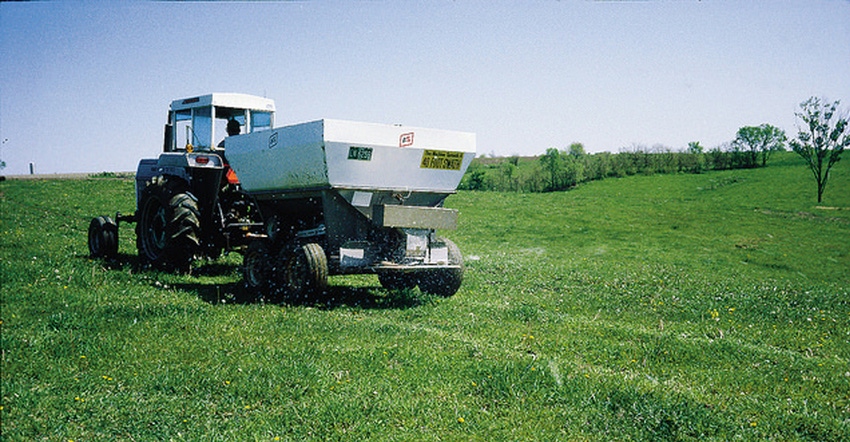January 22, 2018

Farmers are often excited to obtain a new piece of farmland. Usually, renting a new farm or tract of land represents a fair amount of effort to develop relationships with landowners, negotiate rental rates and create a rental agreement.
The excitement may soon be tempered by realties of the input requirements of the new farm. The land may need some updates, such as tile drainage, fence removal, tree removal, maintenance of conservation structures, maintenance of field drives, etc.
There may also be agronomic considerations. Soil tests may reveal low levels of soil test phosphorus and potassium, and acidic soils may require a lime application. The following thoughts and suggestions can help prioritize some of the decisions.
Sample, test soil
First order of business is to have the soil sampled. Grid samples may be the best place to start. Collecting soil samples on a 2.5- to 4-acre grid or according to soil map units will be useful. Check for phosphorus, potassium and soil pH. Also, realize there may be high-pH soil areas that may require an Olsen or a Mehlich-3 test method to accurately reflect soil phosphorus levels.
New farms are notorious for low levels of soil test P or K, where previous operators may have anticipated a change in farming plans and applied low rates of P and K fertilizer. As the new tenant, you have a choice: apply the recommended rate, which will build soil test levels of P and K, or proceed slowly and apply less.
ISU recommendations backed by research
Agronomists at Iowa State University studied this very topic and have generated recommendations based on long-term soil fertility research.
Soil test levels in the very low category for phosphorus will receive a recommendation of 100 pounds P₂0₅ per acre for corn or 80 pounds P₂0₅ per acre for soybeans. These application rates will maximize corn and soybean yield and at the same time help create higher soil test levels in the future.
Similarly, very low soil test levels of potassium will receive an application recommendation of 130 pounds K₂0 per acre for corn or 120 pounds K₂0 for soybeans.
ISU research shows applying the 100 pounds per acre of P₂O₅ and the 130 pounds per acre of K₂O for corn, for example, will maximize yields. However, many farmers may not want to incur this cost during the first year of the lease. In this case, applying crop removal rates of about 20 to 30 pounds per acre lower will result in a higher economic return in fertilizer investment, but won’t allow for all the yield potential or increase soil test levels much.
Some crop advisers suggest applying higher-than-recommended rates for low-testing soils to build up soil phosphorus and potassium faster, although this will not increase yield further. This practice could make sense with safe land tenure and good crop prices, but not with uncertain future land tenure and current low crop prices.
Removal rates of P, K
Soil test results showing soil is in the optimum category for P and K should be maintained by applying crop removal nutrient rates. Information in ISU Extension publication PM 1688, “General Guide for Crop Nutrient and Limestone Recommendations in Iowa,” can be used to estimate phosphorus or potassium fertilizer application rates according to site-specific yield levels and average concentrations in grain and the prevailing yield.
For example, corn yielding 180 bushels per acre will remove 58 pounds of P₂0₅ and 40 pounds of K₂0 per acre. A 55-bushel bean crop will remove 40 pounds of P₂0₅ and 66 pounds of K₂0. In a corn-soybean rotation, you would apply 98 total pounds of P and K fertilizer for corn and 106 pounds total for soybeans. The fertilizer would be applied once every two years, usually following the soybean crop.
Soil pH may need some help also. Consider liming to a pH of 6 for soils in western, northwest and north-central Iowa (where high pH subsoils occur). Soil pH should be corrected to a pH of 6.5 in parts of the state where subsoil is acidic. Some people believe the soybean crop will be the main beneficiary of the corrected pH, but this is not the case. Corn and soybeans respond about equally to increased soil pH.
Consider an aglime application of 1,500 pounds per acre of effective calcium carbonate equivalent (ECCE), where input capital is limited and soil pH is less than 6. Soil pH will not be corrected with this partial application rate, but the yield potential will be temporarily restored.
Kassel is an Iowa State University Extension field agronomist in northwest Iowa. Contact him at [email protected].
Soil fertility website updated
The Iowa State University Extension Soil Fertility website has undergone a redesign and update. While the site has been a resource for several years, it was in need of an overhaul. Part of the update was to improve flow and access to the different areas of the site.
The original area of “Nutrient topics” is still there, such as lime and soil pH, nitrogen, phosphorus, potassium, manure nutrients, secondary and micronutrients, soil and plant sampling and testing, and nutrients and water quality.
In each nutrient topic section, information is available pertinent to the topic: Extension and Outreach publications, newsletter articles, conference proceedings and reports, presentations, and links to related websites.
The photo gallery still has a large number of nutrient-related pictures. As before, the “Current topic” articles are located on the main page. New features include a “Quick links” list, and a featured website or publication on each page.
About the Author(s)
You May Also Like






